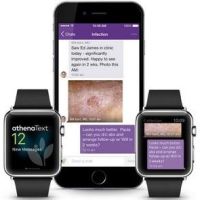Medical students learning to relate to patients often interact with “standardised patients” portrayed by healthy people who are trained to act like real patients. The drawback of that type of interaction is that it is relatively expensive, and students do not always get to experience the range of patient personalities. Computer-based virtual patients have their limitations, too, such as a lack of emotional expression which might be displayed by real patients in a clinical setting.
Researchers at Ohio State University’s Advanced Computing Center for the Arts and Design (ACCAD), in collaboration with Wexner Medical Center’s Doug Danforth, have built several avatars as part of the Virtual Patient Project. The avatars appear life-sized on a large computer screen in a room that is set up like a medical office, to help students in training. The research team also included associate professor of design Alan Price and former MFA gradate student in design Kellen Maicher, who is currently an interactive media consultant.
“Dr. Danforth came to ACCAD to see if we could build an avatar that would create a rich, high-fidelity experience for the medical students,” Price explained. “The virtual patients are designed so students can practice interviewing, asking the right questions and developing effective communications skills.”
Medical students thus interact with the virtual patients in a more true-to-life way, practicing their clinical skills with credible virtual patients. The avatars, which represent different ages and genders, complain about commonplace ailments such as abdominal pain, back aches, chest pain, cough and headaches. Different facial and emotional tags allow for the avatars to present several emotional responses, more accurately replicating a real doctor-patient relationship.
“The student will ask the avatar questions, and will get responses, and emotions, back. They’ll be able to practice and test their skills one on one with a life-like patient. It will allow them to do all of the ‘detective work’ on a new patient and get immediate feedback from that patient,” said Danforth, an associate professor of obstetrics and gynaecology.
Through the program’s web-based version, medical students can access the avatars from home or on the road using laptops and personal computers. This makes it possible for students to easily practice the manifold personal exchanges that take place between doctors and patients, such as keeping patients calm while probing for details of their ailments and narrowing down possible diagnoses.
“We want the avatar to elicit emotions, rather than just being robotic and cold. The emotional element helps students develop their clinical skills in the exam room,” said Maicher, whose MFA thesis involved the development of affect in virtual characters. Maicher built the characters in a computer animation studio and imported them into a gaming engine. A database built by Danforth helped to achieve the avatars’ credible communication.
“Nobody to my knowledge is using avatars, artificial intelligence and virtual reality that combine communication and emotion,” Danforth said.
Source: Ohio State University
Image Credit: Ohio State University



























